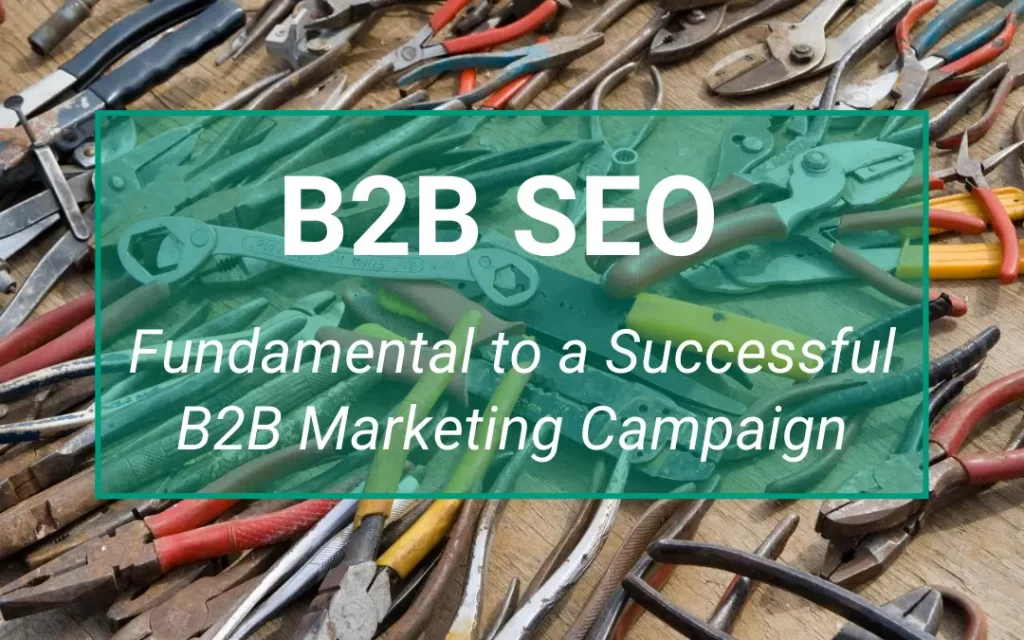There’s no denying the benefits of great SEO. Over 70% of internet traffic comes from the top five organic search engine results, with the first result raking in over a quarter of the traffic for any given search query. Gaining placement in those results ensures a business gains immense visibility, improved credibility and better marketing results.
Oftentimes, however, larger companies put the majority of their marketing budgets into PPC campaigns, completely neglecting SEO. After all, why do all that work when you can simply buy your way into the top spot?
But doing this is ignoring a huge opportunity to improve your marketing ROI over the long term.
Table of Contents
ToggleWhy B2B SEO is Different
Whether it’s an ecommerce shop that sells shoes or a B2B business selling a CRM solution, the fundamentals of SEO remain the same, with the goal being driving more traffic. This is accomplished through a combination of:
On-Site SEO, which focuses on the technical aspects of your website and ensuring that all of Google’s 200+ ranking signals are well optimized for. This means having a fast, secure, technically sound website that doesn’t deviate from standards and works well across all devices.
Off-Site SEO, which involves providing search engines with quality content that’s relevant to user’s search queries. This means creating and publishing content that answers people’s questions in an engaging way. It also means having a deep understanding of your target audience and learning about the kind of information they seek and how to provide it to them in an industry-specific way.
Yet, while these principles apply to all websites, the differences in B2B SEO are stark. B2B sales cycles are vastly more complex. Each prospect that starts down the sales funnel could take months to reach the purchase phase. What’s more, for a single business, there are usually multiple decision-makers traversing the sales funnel, each one in different stages.
In other words, the way you approach B2B SEO differs significantly from consumer SEO. And while this should come as no surprise, it’s worth taking a closer look at, because these added complexities mean unique challenges in B2B SEO.
But they often mean unique benefits, too.
Increasingly Complex Sales Funnels
Think about the level of thought, research and consideration that goes into buying a piece of clothing or a pair of shoes on an ecommerce website. Now consider the same for a business that’s looking at investing in a new SaaS solution. It’s easy to see which one is more complex.
There’s also the challenge of making sure your business is visible in search engines for every part of the sales funnel. From the awareness stage all the way down to the purchasing phase, your business needs to provide prospects with relevant, informative content to move them along the path toward a loyal customer.
More work? Certainly. But once that work is done, you’ll have relevant content appearing in search results for every stage of your sales cycle. And that means more opportunities for targeted web traffic without paying for a PPC campaign.
Keyword Challenges
B2B SEO is particularly challenging on the keyword front. Because of the added complexity across products, services and sales funnels, B2B-specific keywords usually have much lower search volume compared to B2C industries.
In other instances, there may not be well-defined keywords at all. This leaves businesses and marketers in the precarious position of drilling down and finding just the right search queries to align with their target audience’s intent.
But this also presents opportunities. Many companies in emerging B2B markets are still in the early stages of SEO, and many don’t pursue it at all, leaving untapped top-of-the-funnel leads on the table, waiting to be capitalized on.
Thoughts on Thought Leadership
A big part of the complexity in B2B search engine optimization comes from the evaluation phase of the sales funnel when a prospect is considering their options. When they’re in this phase, buyers want to feel confident that the company they’re looking at has the right solution for their needs. And this is happening long before they pick up their phone or fire off an email.
To instil this confidence, your business needs to demonstrate its expertise with a decidedly confident and engaging media presence. You need to present your business as an industry leader that has the experience, talent and passion to provide the best solution available. One of the best ways to do this is through thought leadership in your industry. This includes demonstrating knowledge and unique insights through:
- Relevant blog posts and white papers
- Guest posting on related websites
- Marketing your content and engaging in conversations across various social channels
- Conferences and webinars
- And more
Granted, this requires a significant investment of resources, but this is precisely the kind of marketing that builds successful brands. It not only fosters loyalty in your existing customer relationships, but it creates awareness and strong equity in future prospects while strengthening your demand generation efforts.
Why the Long Game Is the Right Strategy
Because of these challenges, many organizations opt to avoid optimizing for SEO entirely. The thinking goes that putting the lion’s share of their marketing budget into PPC campaigns is a better investment. And while that seems to make sense, it’s short-selling your efforts and locking your business into slim returns on its investment.
With PPC campaigns, you’re essentially paying for website traffic indefinitely. And advertising costs are only trending higher: Digital advertising spending is forecasted to hit $640 billion by 2024, up from $378 billion in 2020. In other words, you’ll hit diminishing returns sooner rather than later, and you’ll need to continuously increase your advertising investment to sustain the same level of traffic.
Playing the long game is the right strategy if businesses want to generate leads in a sustainable way. SEO channels built over time provide the most stable form of leads for any organization. And even though investing in organic traffic can eclipse the cost of a PPC campaign, keep in mind that once your PPC campaign stops, so do your leads. Put simply, the potential ROI on organic SEO is far more substantial than PPC in the long run.
Diversifying your lead sources with SEO alongside a robust content strategy provides much more stability, and it’s an investment that returns dividends, so to speak. By publishing evergreen content that continuously engages your prospects and customers, you’re moving away from a pay-by-lead model and embracing a more holistic approach. An approach that fosters awareness and brand loyalty — something that’s impossible to put a price tag on.
PPC as a Tool, Not a Crutch
Despite the clear benefits of building an organic SEO presence, PPC still has its place in marketing. But it’s important to see it as a tool in your toolbox rather than a crutch to stand on. In fact, when used in conjunction with search optimization, it can help push your organic traffic into overdrive.
In any SEO campaign, you’re going to form a list of high-value keywords that you’ll want to focus on in your content strategy. The problem is that, while your list may seem like natural choices for your business, they may require an enormous amount of effort to rank for. As a business, you need to know what kind of financial returns you’ll get from investing in them.
This is where PPC can help. You can buy your preferred keyword’s traffic for a month or two and measure traffic with a tracking campaign to determine the quality of the visitors using those particular keywords. If the keywords you’re testing produce value, you know they warrant serious investment on the SEO side of things.
Long story short, PPC campaigns can enable you to identify what is and isn’t working well before you spend months attempting to rank for a given keyword.
The Bottom Line
Large B2B organizations often ignore SEO entirely and dump their marketing budgets into PPC campaigns. Doing this is missing out on huge opportunities to expand lead acquisition, leverage brand loyalty through thought leadership and substantially improve their marketing ROI.
As a business, you can continue paying daily for the privilege of your current traffic, or you could build a content strategy that generates leads for years to come. Looking at the ROI over a longer period of time, it’s easy to see how SEO can be a significant force in your business’s marketing.
Ultimately, paid ad campaigns will continue increasing in costs, so the savviest B2B marketers should be on the lookout for ways to expand their lead acquisition channels by means such as SEO.











